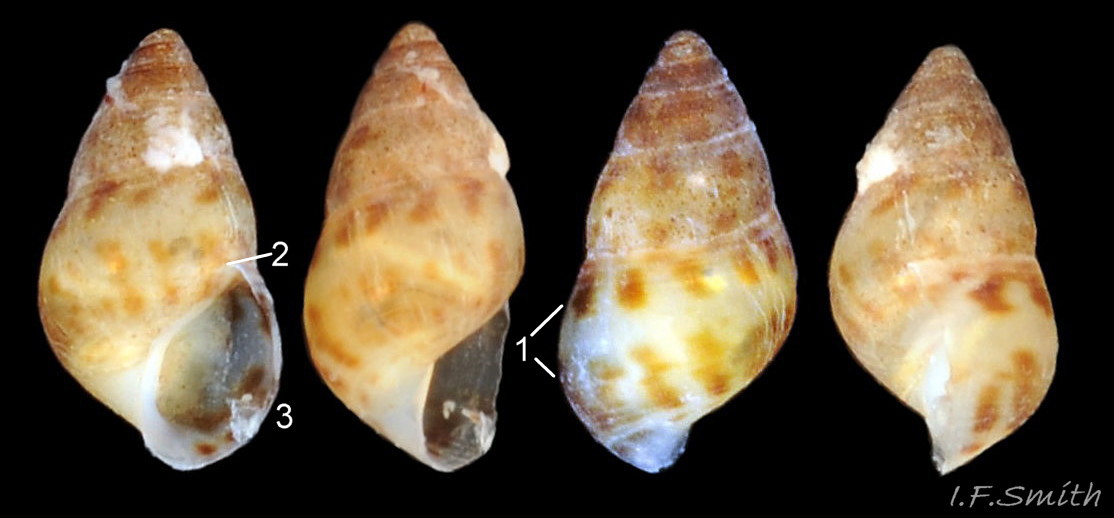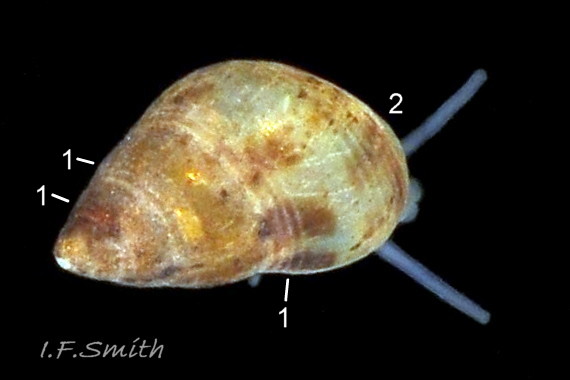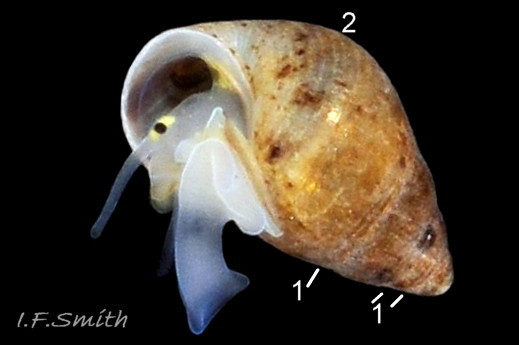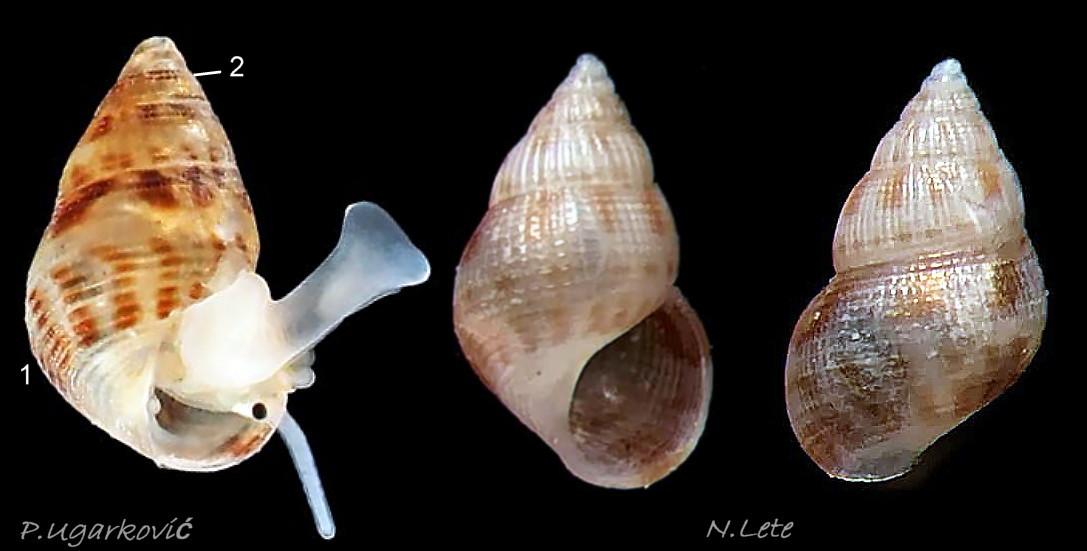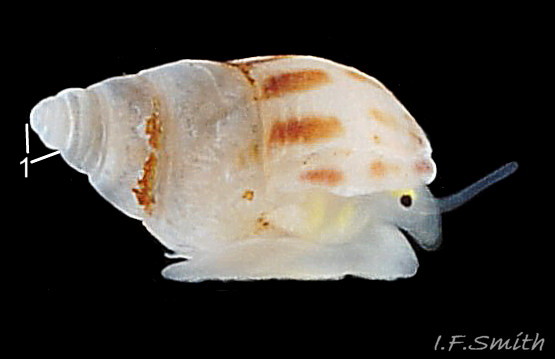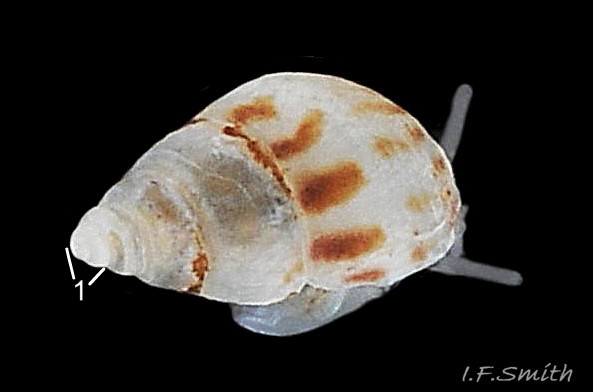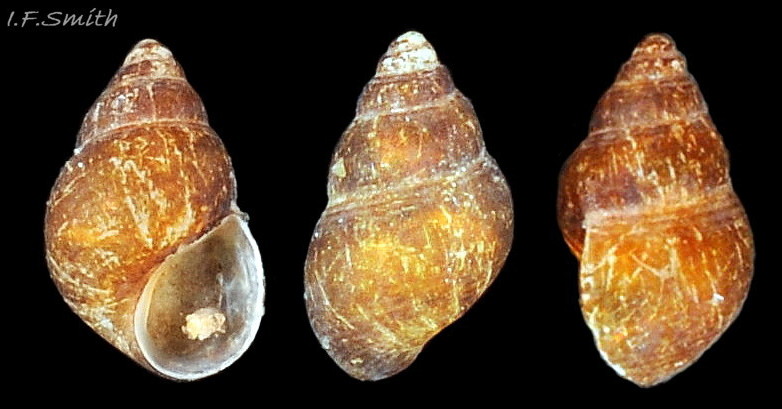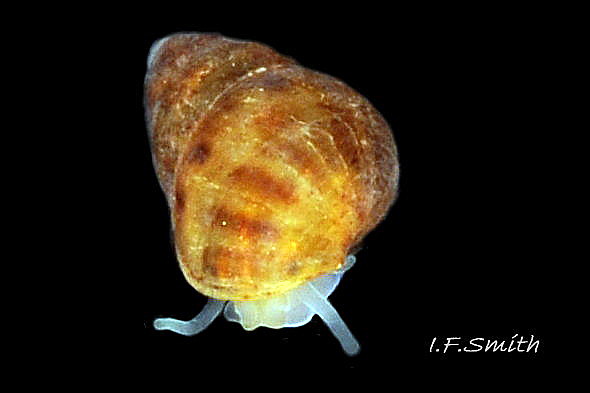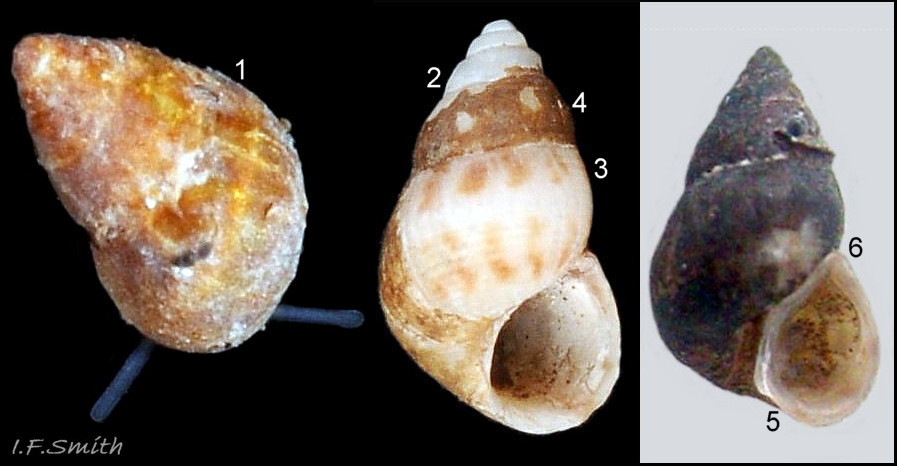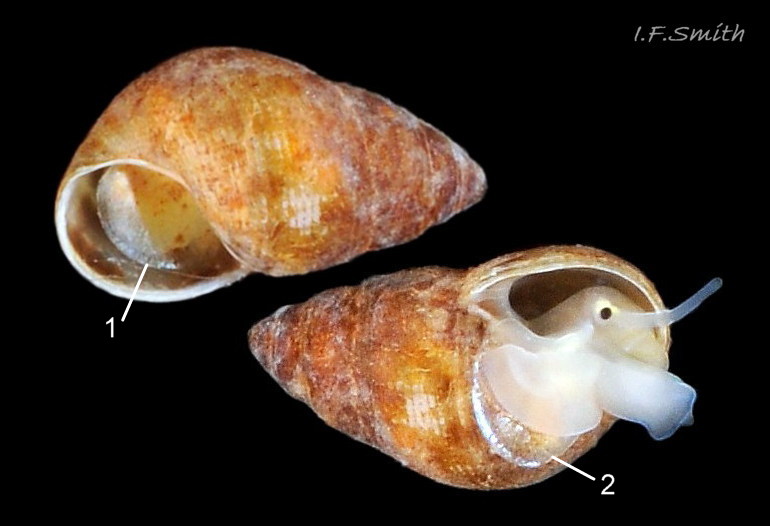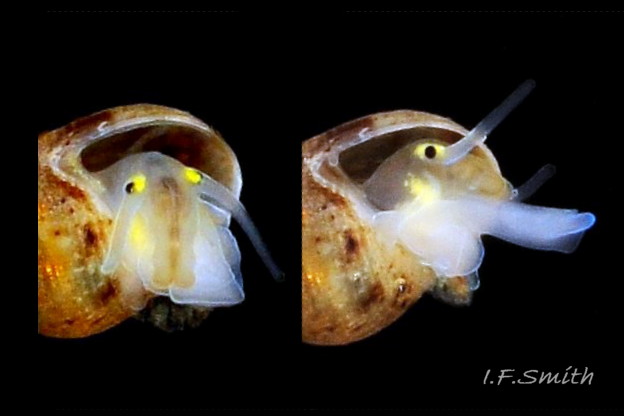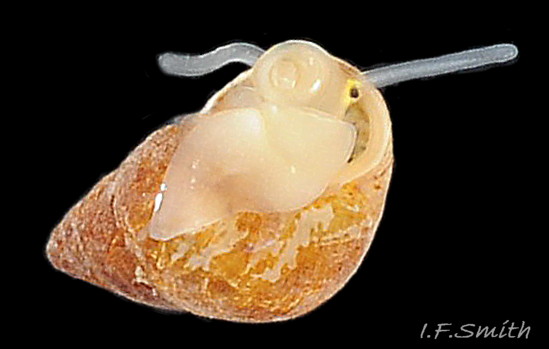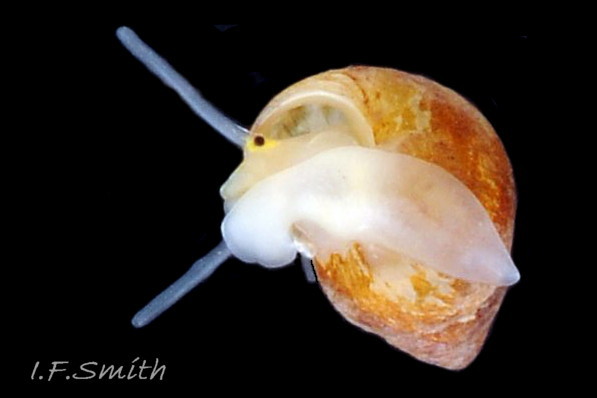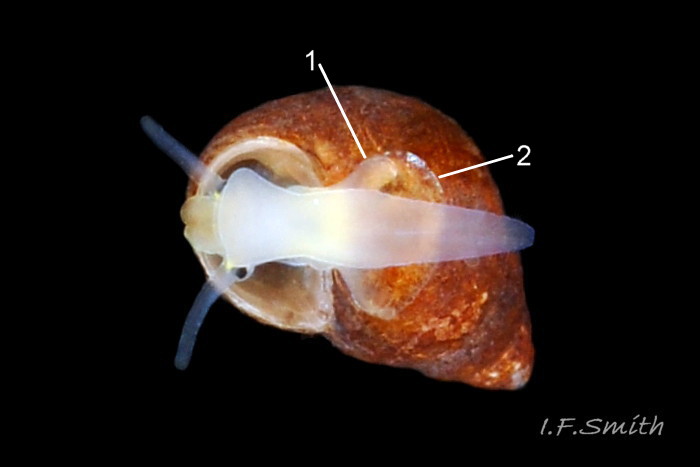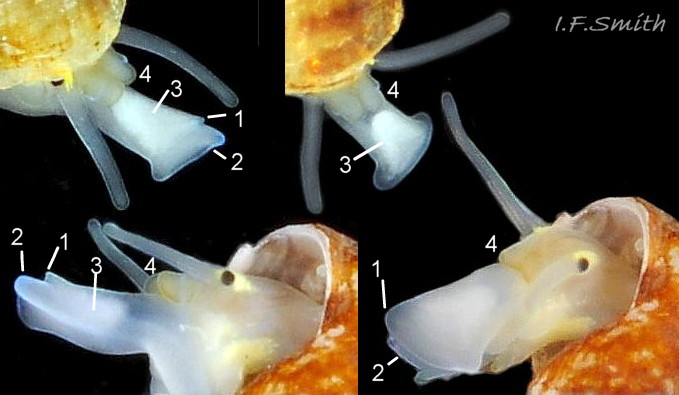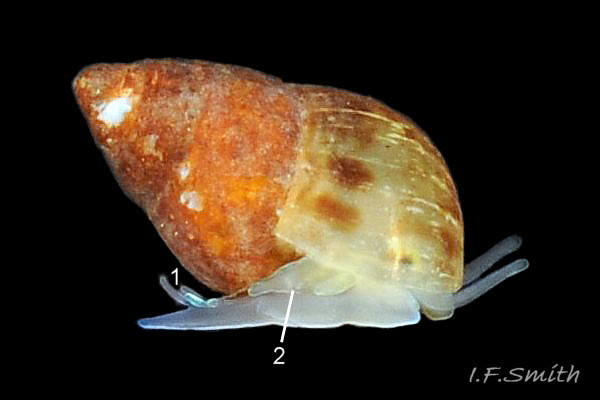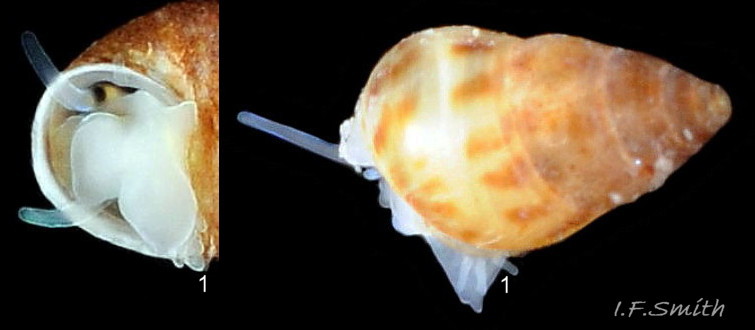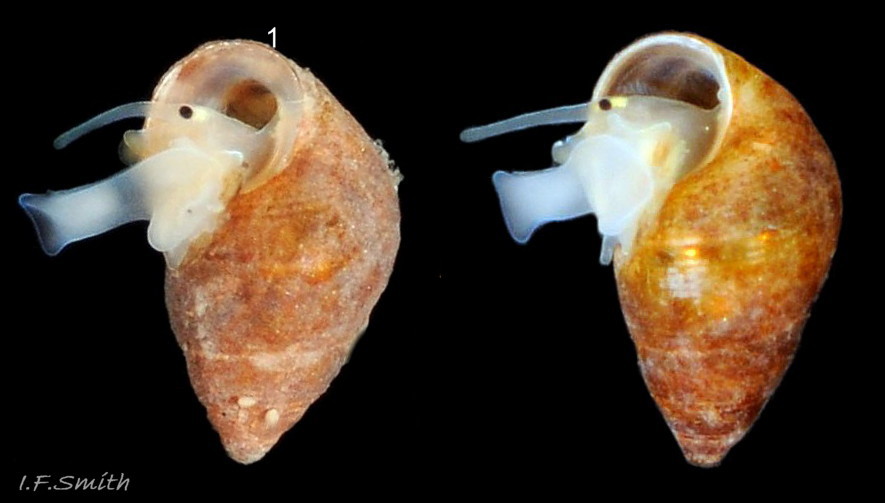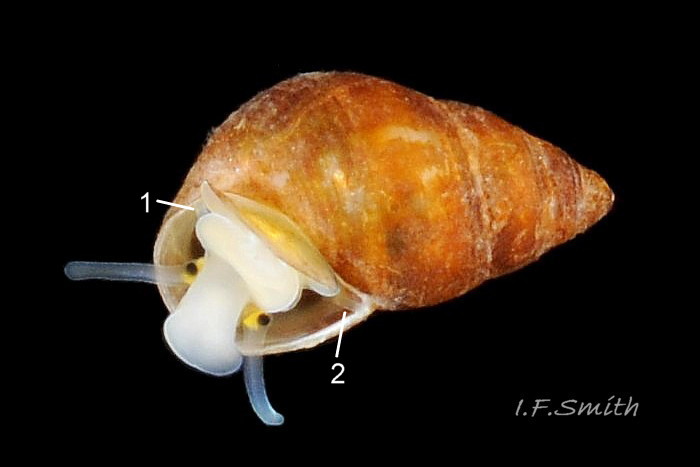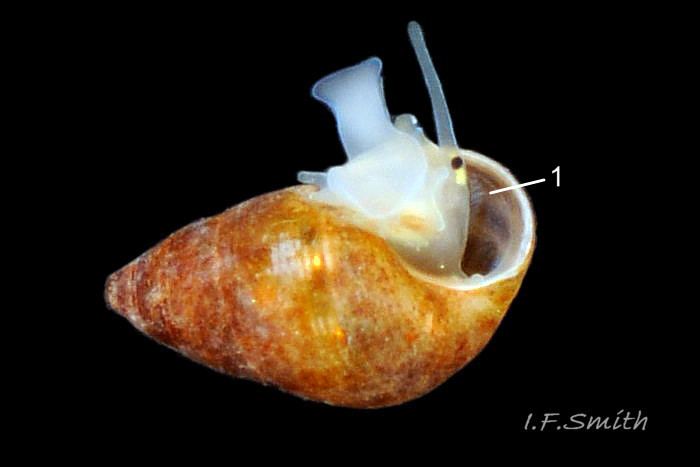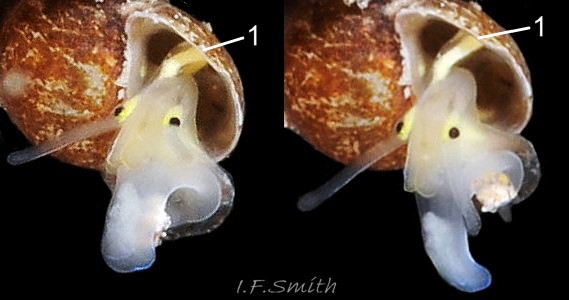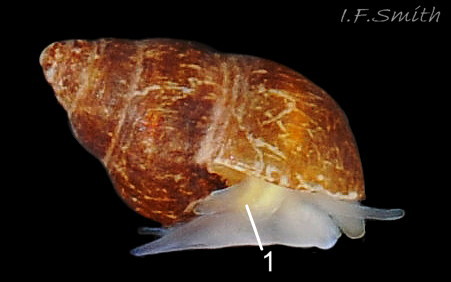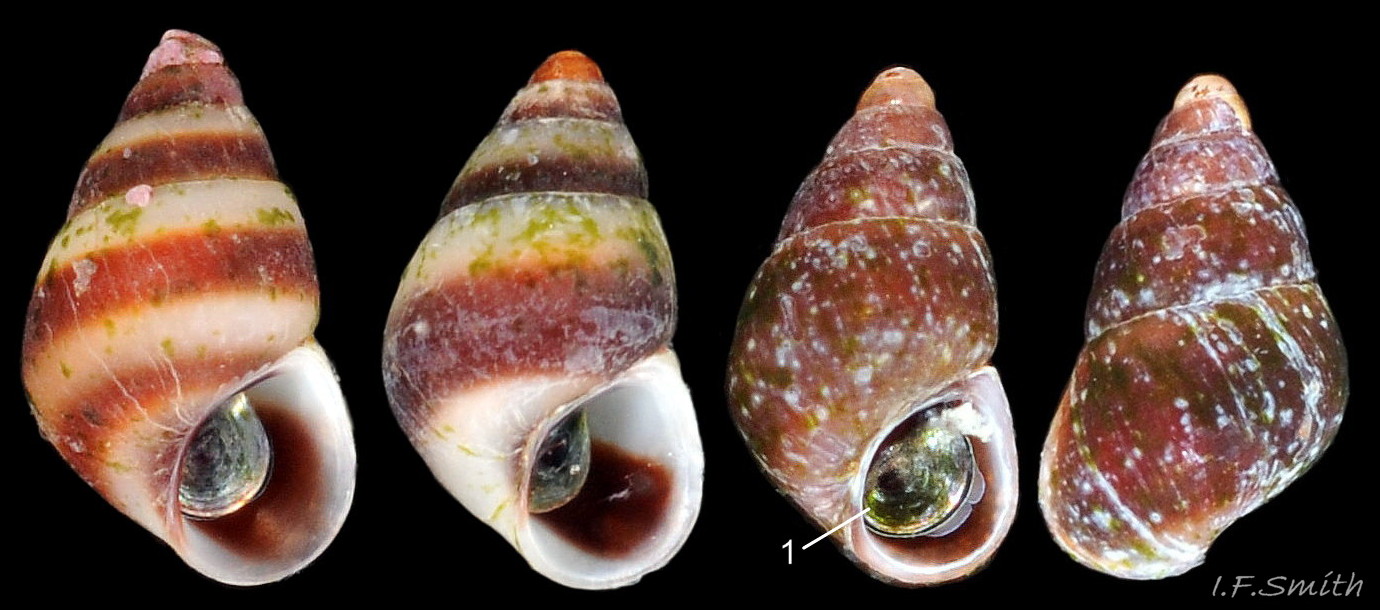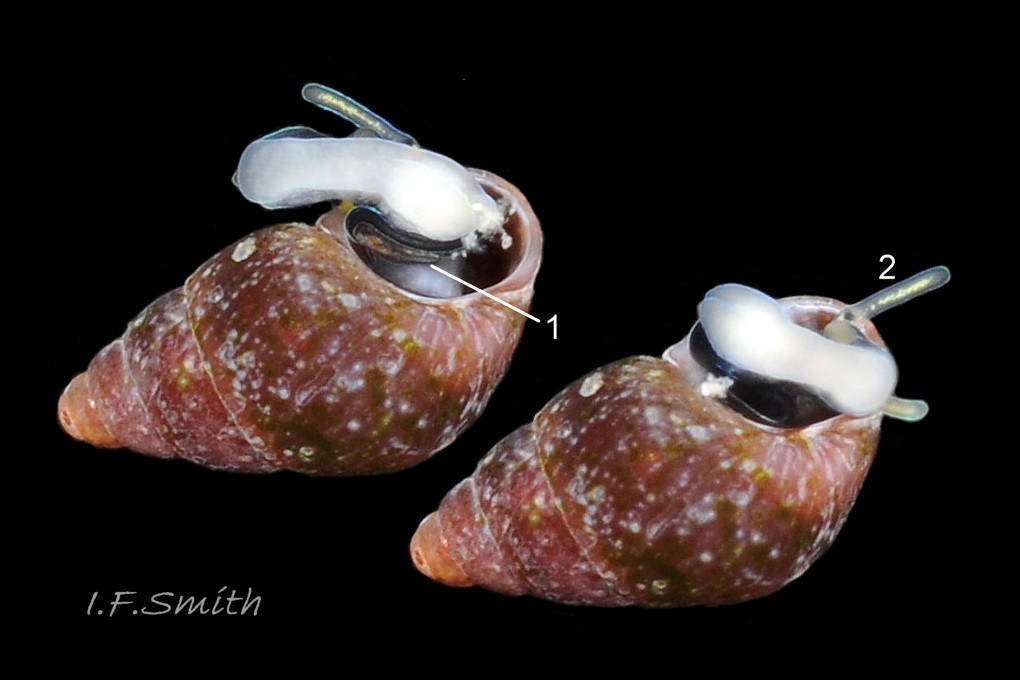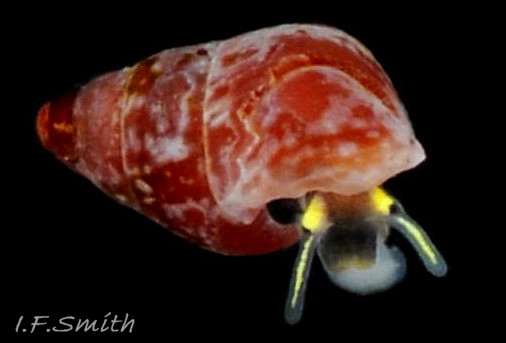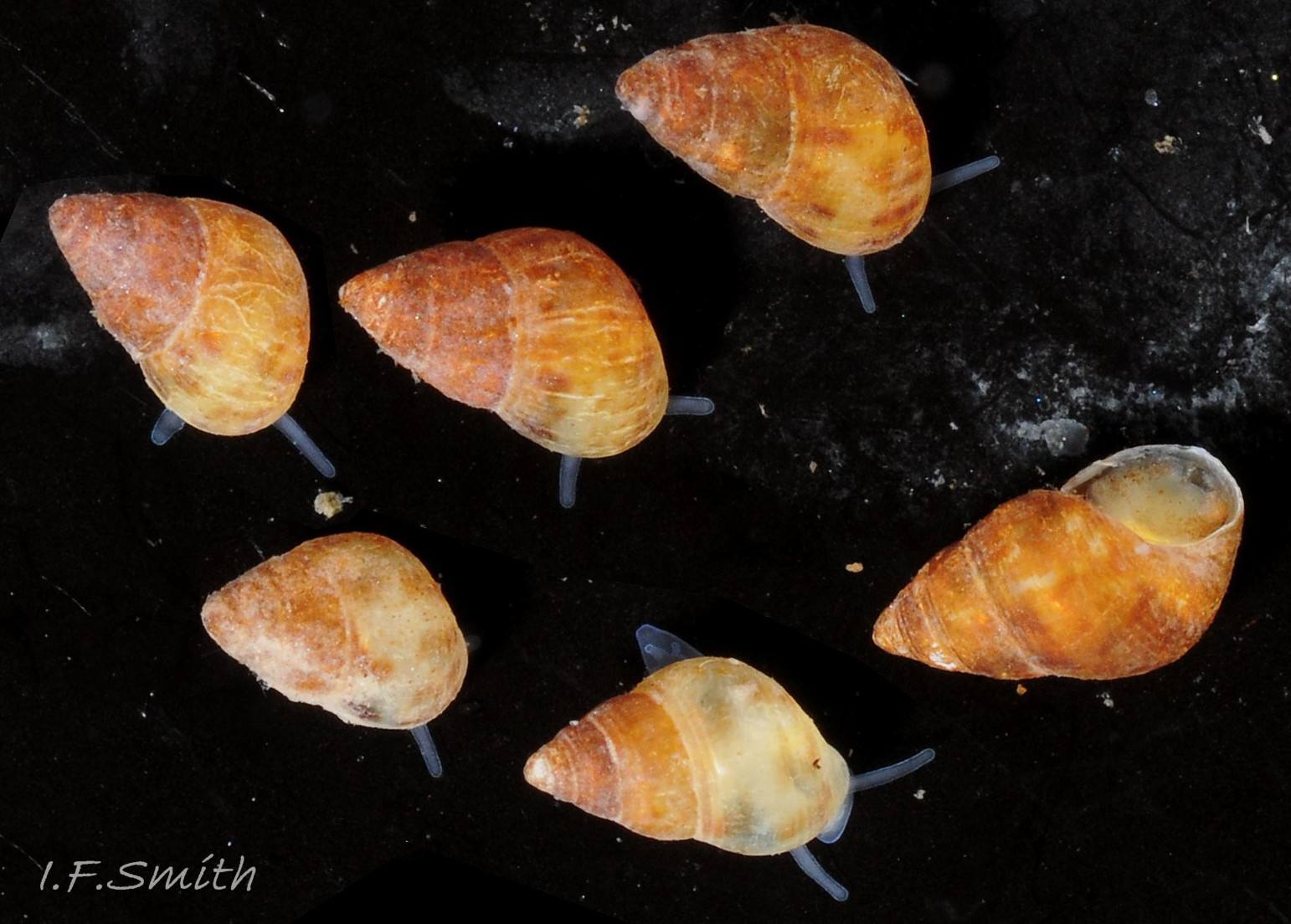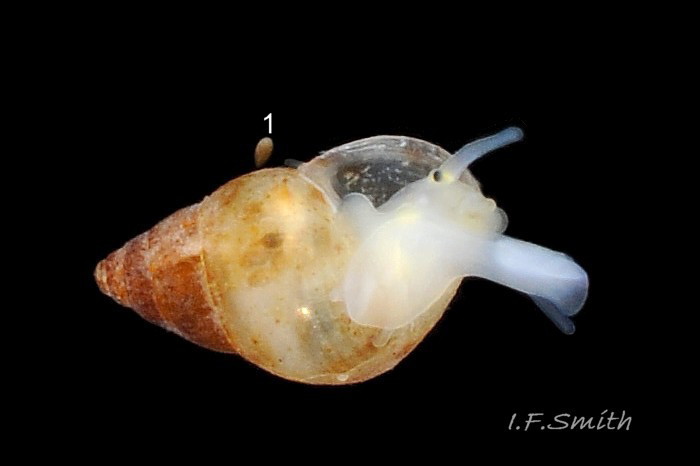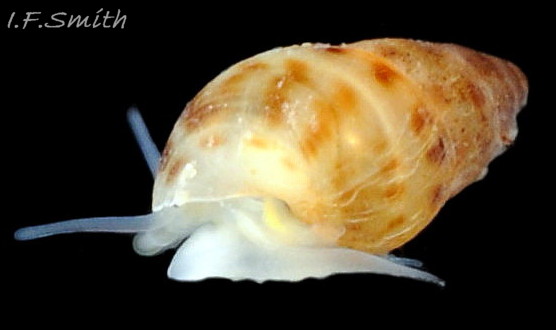Click image to enlarge with full caption. Main text below slider.
Crisilla semistriata (Montagu, 1808)
Synonyms: Turbo semistriatus Montagu, 1808; Alvania semistriata (Montagu, 1808); Cingula semistriata (Montagu, 1808); Rissoa semistriata (Montagu, 1808).
Current taxonomy: World Register of Marine Species (WoRMS)
www.marinespecies.org/aphia.php?p=taxdetails&id=141280
Vernacular: Marmoreret tangsnegl (Danish), Gestreepte traliedrijfhoren, Gestreept drijfhorentje (Dutch).
GLOSSARY below.
Shell description
The shell height of C. semistriata is about twice that of the width; it grows up to 3 mm high and 1.6 mm wide. The shell is oval-conical and moderately tall with slightly tumid whorls and distinct sutures. The spire is about 33% of the shell height, with an apical angle of about 40º 01 Crisilla semistriata .
The surface has fine strap-like spiral ridges; about 24 on the body-whorl, but often only those just below the suture and those on its lower half are discernible 02 Crisilla semistriata & 03 Crisilla semistriata . There are also very delicate growth lines crossing the spiral ridges. In southern Europe the growth lines and spiral ribs are often more distinct and create a punctate surface which is masked by the periostracum on many unworn live specimens 04 Crisilla semistriata .
When there is no periostracum, the shell is glossy translucent white 04 Crisilla semistriata . When occupied, the body makes it appear less translucent 05 Crisilla semistriata and viscera may show as faint greyish and brownish patches 06 Crisilla semistriata . The protoconch of 2.25 whorls, diameter 0.3 mm, is pure opaque white 05 Crisilla semistriata & 06 Crisilla semistriata . When a periostracum is present, there is no glossiness and the colour varies with its thickness from pale yellowish 01 Crisilla semistriata to brown 07 Crisilla semistriata . There are two spiral rows of large brown marks on the body whorl 02 Crisilla semistriata & 08 Crisilla semistriata but the lower row sometimes breaks into more rows of smaller marks 01 Crisilla semistriata & 04 Crisilla semistriata . On some the marks are very faint or absent. Sculpture and coloured marks can be obscured by the yellowish to brown periostracum, which in Britain can be very thick 09 Crisilla semistriata .
The aperture is oval with an adapical angle of about 60º 09 Crisilla semistriata . Its height is 40% to 45% of the shell height. On mature shells there is a well developed, continuous, basally flared, white peristome around the aperture, which is most distinct on shells with a thick contrasting periostracum 09 Crisilla semistriata . On younger shells the lip is thinner. The brown exterior marks are often visible from inside the aperture 01 Crisilla semistriata . The columellar lip is reflected onto the body-whorl and conceals the umbilical groove.
The operculum is pale horn-colour and translucent showing the underlying, yellow opercular disc 10 Crisilla semistriata .
Body description
The flesh is translucent white. The bifid, translucent snout is tinted yellowish brown either side of the oral tube 11 Crisilla semistriata . It has a slit at the end which opens into a circular mouth 12 Crisilla semistriata .The translucent white cephalic tentacles have no markings apart from a yellow patch in the slight basal swelling which bears a black eye13 Crisilla semistriata .
At full extension the translucent white foot and head are not as long as the shell 14 Crisilla semistriata & 15 Crisilla semistriata . It is widest at the axe-head shaped anterior and, after a waist, tapers to a rounded point at the posterior. The bilaminate anterior contains the wedge shaped, opaque-white, anterior pedal mucous gland which has its opening between the laminae 16 Crisilla semistriata . The small posterior pedal gland opens on the midline in the widest posterior part of the foot. The operculum rests on a yellow-blotched opercular disc which extends as prominent, translucent white, opercular lobes 14 Crisilla semistriata . Three or four metapodial tentacles protrude from under the posterior of the operculum 17 Crisilla semistriata & 18 Crisilla semistriata . The mantle forming the mantle cavity varies from brownish to light buff 19 Crisilla semistriata . It can extend to cover the white peristome. There are two transparent almost invisible pallial tentacles; one on the right and the other extending from near the adapical angle of shell-aperture 20 Crisilla semistriata . Within the mantle cavity there is a small ctenidium with nine filaments 21 Crisilla semistriata . A long yellowish white penis is attached behind the right tentacle of males. It may be doubled back into the mantle cavity 22 Crisilla semistriata or protrude from the shell 23 Crisilla semistriata & 17 Crisilla semistriata .
Key identification features
Crisilla semistriata
1) Maximum shell-height 3 mm.
2) Shell whitish with two spiral rows of brown marks on the body-whorl 02 Crisilla semistriata & 08 Crisilla semistriata . But those with thick periostracum are entirely brown.
3) Spiral ridges on body whorl (may be hidden by thick periostracum).
4) Operculum is translucent pale horn-colour showing yellow opercular disc when live 10 Crisilla semistriata .
5) Head and snout translucent whitish with tinted yellowish brown either side of the oral tube 11 Crisilla semistriata .
6) Cephalic tentacles translucent white with no markings.
Similar species
Barleeia unifasciata
1) Maximum shell-height 3 mm.
2) Some shells have prominent, broad, whitish and brownish-red bands, but others are entirely brownish red 24 Crisilla semistriata COMPARE Barleeia unifasciatal .
3) No spiral ridges on body whorl.
4) Operculum very dark crimson (often looks black on live animal); outer face convex 25 Crisilla semistriata COMPARE Barleeia unifasciata often with silvery refringence.
5) Head and snout pale-yellowish overlain by blackish “smoked-glass” effect (varies in intensity) 26 Crisilla semistriata COMPARE Barleeia unifasciata .
6) Cephalic tentacles translucent white with bright yellow basal eye-patch and bright yellow longitudinal line 26 Crisilla semistriata COMPARE Barleeia unifasciata .
Habits and ecology
C. semistriata is found in silty situations below rocks and in crevices on the lower shore and to 100 m sublittorally. It is often found with Onoba. It feeds, often gregariously 27 Crisilla semistriata , on organic detritus.
The faeces are oval pellets 28 Crisilla semistriata . The anterior pedal mucous gland 16 Crisilla semistriata discharges within the bilaminate anterior edge of sole which spreads mucus to lubricate creeping.
When in motion the snout and cephalic tentacles protrude beyond the shell, but the foot usually remains below it 29 Crisilla semistriata .
At Plymouth it breeds from March to August. The female is fertilised internally by the male’s long penis 22 Crisilla semistriata & 23 Crisilla semistriata . Hemispherical, transparent colourless spawn capsules, about 0.6mm diameter, containing 12 to over 20 eggs, are laid on weed or other surfaces. They hatch as veliger larvae which develop a thin red line on the velum and red marks on the foot as they grow. After time in the plankton they settle and metamorphose. The lifespan is probably one year.
Distribution and status
C. semistriata is found from Norway to the Mediterranean, but not in the Black Sea, Baltic or most of the continental coast of the North Sea from Denmark to Belgium; GBIF map www.gbif.org/species/4361366 . It occurs on rocky coasts of Britain and Ireland, being common in the south and scarce in the north, and is scarce or absent in the north-east Irish Sea and coast of East Anglia, U.K. map NBN species.nbnatlas.org/species/NHMSYS0021055524 But even when present it is often overlooked because of its small size; there are only eight records from the Atlantic and Mediterranean on iNaturalist www.inaturalist.org/observations?taxon_id=482250 (accessed 17 April 2023).
Acknowledgements
I thank Neven Lete and Pero Ugarković for use of images, and Paul Brazier for specimens.
Links and references
Forbes, E. & Hanley S. 1849-53. A history of the British mollusca and their shells. vol. 3 (1853), London, van Voorst. archive.org/details/historyofbritish03forbe/page/116/mode…
Fretter, V. and Graham, A. 1962. British prosobranch molluscs: their functional anatomy and ecology. London, Ray Society.
Fretter, V. and Graham, A. 1978. The prosobranch molluscs of Britain and Denmark. Part 4– Marine Rissoacea. J. Moll. Stud. Suppl. 6, 153-241
Fretter, V. and Pilkington, M.C. 1970. Prosobranchia. Veliger larvae of Taenioglossa and Stenoglossa. Conseil international pour l’exploration de la mer. Fiches d’identification. Zooplankton, 129-132.
ices-library.figshare.com/articles/report/Prosobranchia_V…
Jeffreys, J.G. 1862-69. British conchology. vol. 4 (1867). London, van Voorst. p.46 archive.org/details/britishconcholog04jeffr/page/46/mode/…
Wigham, G.D. & Graham, A. 2017. Marine gastropods 2: Littorinimorpha and other, unassigned, Caenogastropoda. Synopses of the British Fauna (New Series) no.61. (344 pages). Field Studies Council,Telford, England.
Glossary
adapical = towards the apex of the shell.
aperture = mouth of gastropod shell; outlet for head and foot.
cephalic =(adj.) of or on the head.
columella = solid or hollow axial “little column” around which gastropod shell spirals; hidden inside shell, except on final whorl next to lower part of inner lip of aperture where hollow ones may end in an umbilicus or siphonal canal.
columellar = (adj.) of or near central axis of spiral gastropod.
columellar lip = lower (abapical) part of inner lip of aperture.
ctenidium = comb-like molluscan gill; usually an axis with a row of filaments either side.
ELWST = extreme low water spring tide (usually near March and September equinoxes).
height = (of gastropod shells) distance from apex of spire to base of aperture.
mantle = sheet of tissue that secretes the shell and forms a cavity for the gill in most marine molluscs.
metapodial = (adj.) of the hind part of the foot.
metapodium = hind part of the foot.
mucus = (noun) viscous, slippery substance secreted by various glands on molluscs.
mucous = (adj.) pertaining to mucus.
opercular = (adj.) of the operculum.
opercular disc = part of foot that growing operculum rests on.
opercular lobe = extension of opercular disc beyond edge of operculum.
operculum = plate of horny conchiolin, rarely calcareous, used to close shell aperture.
pallial = (adj.) of, relating to, or produced by the mantle (pallium).
peristome = rim round shell-aperture.
plankton = animals and plants that drift in pelagic zone (main body of water).
umbilicus = cavity up axis of some gastropods, open as a hole or chink on base of shell, often sealed over.
suture = groove or line where whorls of gastropod shell adjoin.
veliger = shelled larva of marine gastropod or bivalve mollusc which swims by beating cilia of a velum (bilobed flap).
velum = bilobed flap of veliger larvae in the plankton.
